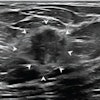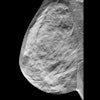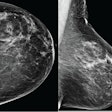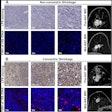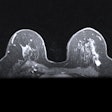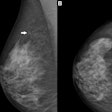For most women between the ages of 40 and 74, biennial screening mammograms are just as effective as annual exams in identifying advanced-stage breast cancer, reported a study published online on Monday in JAMA Internal Medicine. Less frequent screening also reduces false-positive results and biopsies.
However, the analysis also determined that women ages 40 to 49 with extremely dense breasts benefited from annual screening mammograms. Women with dense breast tissue who opted for biennial exams had nearly twice the risk of being diagnosed with advanced-stage cancer, and more than twice the risk that the tumor would be large.
"For women aged 40 to 49 years with extremely dense breasts, who have increased risk of advanced-stage disease and missed breast cancers by mammography, annual screening has added benefit to detect breast cancer at an earlier stage then biennial screening," the authors wrote.
The 2009 USPSTF decision
The backdrop for the research was the decision in 2009 by the U.S. Preventive Services Task Force (USPSTF) to change its guidelines on screening mammography. USPSTF changed its recommendation for women ages 50 to 74, recommending biennial mammography rather than the previously recommended frequency of every one to two years. USPSTF also stated that women younger than 50 might not need annual screening mammograms, which generated a firestorm of controversy.
However, the updated guidelines did not consider the influence of breast cancer risk factors beyond age. So a group led by Dr. Karla Kerlikowske, a professor in the University of California, San Francisco departments of medicine and epidemiology/biostatistics, sought to determine whether screening mammography's benefits and harms differ among women according to age, breast density, and postmenopausal hormone therapy use.
The data were collected prospectively from community practice facilities in the U.S. that participate in the Breast Cancer Surveillance Consortium (BCSC) mammography registries. The analysis included more than 934,000 women who had one or more mammograms from January 1994 to December 2008 (JAMA Intern Med, March 18, 2013).
Women with breast cancer
From the initial population, the researchers found 11,474 women who had been diagnosed as having breast cancer. The majority were Caucasian and 50 years of age or older, and the women were roughly evenly split between those with less dense breast tissue and those with denser tissue.
The researchers classified breast density into four categories: fatty, scattered fibroglandular densities, heterogeneously dense, and extremely dense. Women with cancer were also divided by screening interval of one, two, or three years. Other variables were also analyzed, such as whether the women had received hormone therapy.
Kerlikowske and colleagues determined that women in the 50- to 74-year age group who had mammograms every other year were not at an increased risk of having more advanced cancer when it was diagnosed, regardless of the density of their breasts or whether they were taking hormones.
However, this was not true for women with extremely dense breasts who were between 40 and 49 years of age. For these women, biennial versus annual mammograms was associated with an increased risk of advanced-stage cancer (odds ratio, 1.89), as well as having a larger tumor (> 20 mm) (odds ratio, 2.39).
In other findings, among the entire population of women with cancer, those with fatty breasts tended to have the lowest frequency of large tumors, while those with extremely dense tissue had the highest frequency. For example, 17.1% of women with fatty breasts screened annually had large tumors, while 32.7% of women with extremely dense breasts had larger cancers. Similar numbers were recorded for cancer stage and likelihood of lymph node involvement.
Risk-benefit analysis
The researchers then addressed the issue of the "harms" of breast screening: specifically, the likelihood of false-positive results and biopsies. For this analysis, they examined data for 922,624 women ages 40 to 74 who had one or more mammograms between January 1994 and December 2008. In this group, more than half of the women with extremely dense breasts were between 40 and 49 years of age.
For women in this age group without extremely dense breasts, both annual and biennial screening mammography exams had "similar risk" of identifying advanced-stage disease, Kerlikowske and colleagues found. The cumulative risk of false-positive screening results and biopsy recommendations would be lower if mammograms were not performed on an annual basis for women in this age group of all breast densities.
However, the authors did point out that the majority of exams in their study were conducted with analog rather than digital mammography equipment. Because the sensitivity of digital mammography is higher in women with extremely dense breasts, their findings might be different if digital mammography represented the majority instead of the minority of exams, they noted.
Women who used estrogen plus progestogen also had a high probability of a false positive, at a risk of 65.8% over a 10-year period. The probability of a false-positive mammogram was 30.7% for women ages 50 to 74 years who had scattered fibroglandular densities when they had a biennial mammogram and 21.9% if they had a mammogram every three years.
Women with fatty breasts had the lowest risk of developing breast cancer, regardless of their age, family history of breast cancer, menopausal status, and hormone therapy use. They also had the lowest cumulative 10-year probability of false-positive mammography results or biopsy recommendations because suspicious lesions are not obscured by normal fibroglandular tissue.
Based on their analysis and results of other published studies, the authors suggested that annual mammograms would not offer any benefit for women with fatty breasts.
"Women aged 50 to 74 years, regardless of breast density or [hormone therapy] use, can undergo biennial rather than annual mammography because biennial screening does not increase the risk of presenting with advance disease but does substantially reduce the cumulative risk of a false-positive mammography result and biopsy recommendation," the authors concluded.
ACR and SBI object to study
The American College of Radiology (ACR) and the Society of Breast Imaging (SBI) issued a highly critical joint statement, stating that the researchers used obsolete clinical end points to assess the effectiveness of current mammography screening. They also said that the study is flawed in its selection of participants and does not include critical information.
Although the authors did not discuss whether annual screening was more effective at identifying early-stage cancer than biennial screening, ACR and SBI made a point of stating that as of 2012, advanced-stage cancer is categorized as being stage Ib rather than stage IIb, which the authors used to signify advanced disease. The outcomes may have been very different if 2012 categorizations were used, the organizations suggested.
ACR and SBI also said there may have been selection bias because the scope of the study did not include genetic risk of breast cancer, a fact that the authors acknowledged. "This renders the study virtually unusable regarding the question of whether to screen women every two years versus annually," according to ACR and SBI.
Finally, the organizations questioned the authors' focus on the risk of false positives and whether the risk level is reduced if screening mammograms are performed every other year.
"The relevance of a false alarm pales in comparison to that of a potential life saved," they stated.
When a cancer is found at an early stage, which an annual mammogram is more likely to do than a biennial mammogram, the extent and cost of treatment would be less, according to the groups.
